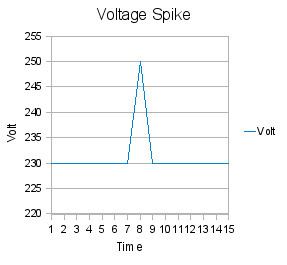 | ||
When the voltage in a circuit or part of it is raised above its upper design limit, this is known as overvoltage. The conditions may be hazardous. Depending on its duration, the overvoltage event can be transient—a voltage spike—or permanent, leading to a power surge.
Contents
Explanation
Electronic and electrical devices are designed to operate at a certain maximum supply voltage, and considerable damage can be caused by voltage that is higher than that for which the devices are rated.
For example, an electric light bulb has a wire in it that at the given rated voltage will carry a current just large enough for the wire to get very hot (giving off light and heat), but not hot enough for it to melt. The amount of current in a circuit depends on the voltage supplied: if the voltage is too high, then the wire may melt and the light bulb would have "burned out real time". Similarly other electrical devices may stop working, or may even burst into flames if an overvoltage is delivered to the circuit.
Conduction path
The transient pulses can get into the equipment either by power or data lines, or directly through space from a strong electromagnetic field change - an electromagnetic pulse (EMP). Filters are used to prevent spikes entering or leaving the equipment through wires, and the devices coupled electromagnetically to space (such as radio-frequency pick-up coils in MRI scanners) are protected by shielding.
